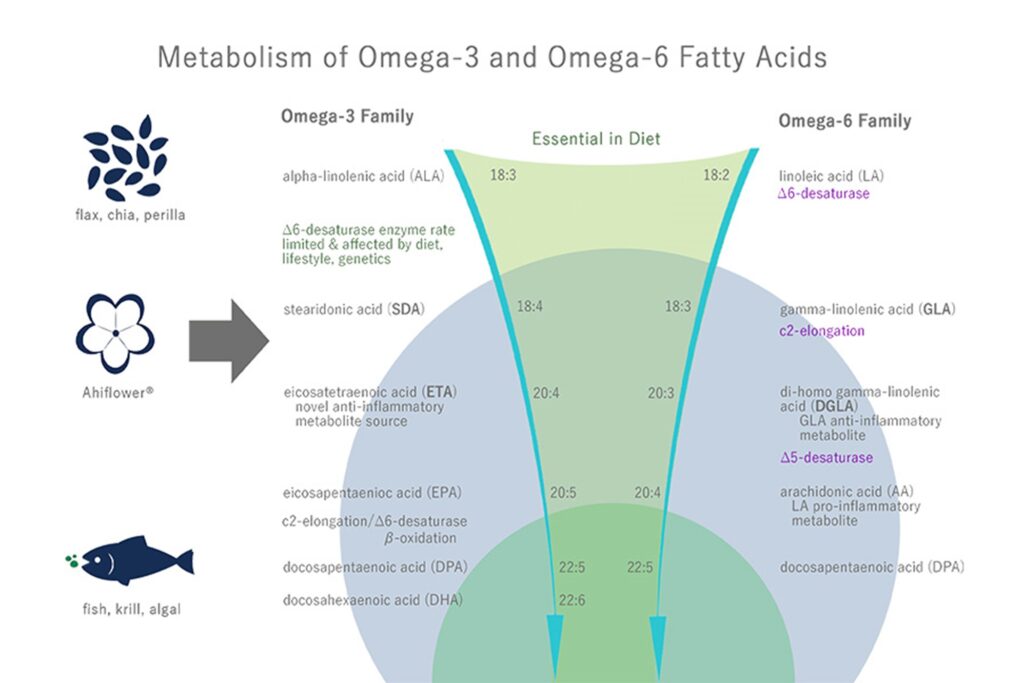Latest research shows ready DHA conversion
Ahiflower® (refined Buglossoides arvensis) seed oil is the newest plant-based entrant in the omega nutrition category. Ahiflower oil has been approved by Health Canada (NNHPD) for product NPN licensing and has been USFDA GRAS reviewed with no objections.
Ahiflower oil contains a uniquely high combination of omega-3 ALA and SDA (stearidonic acid) plus omega-6 GLA (gamma linolenic acid). Its total polyunsaturated fatty acid (PUFA) content is about 85%, among the highest in the plant kingdom. It is the richest dietary source of SDA at about 20%. Both SDA and GLA bypass the hepatic delta-6 desaturase rate limiting step, making Ahiflower the most biologically advanced plant-based omega source in terms of longer-chain PUFA biosynthesis. See Fig. 1.

(Provided with permission from Natures Crops International.)
Other commercially available dietary SDA and GLA sources include echium oil, hemp seed oil, and black currant seed oil, but Ahiflower oil leads by far compositionally. See Chart 1.
Chart 1. Highest SDA-Containing Plant-Based Dietary Oils
| Key Fatty Acids | Ahiflower (%) | SDA Soya* (%)1 | Echium (%)2 | Hemp (%)3 | Black Currant (%)4 |
|---|---|---|---|---|---|
| ALA (c18:3, n-3) | 42-48 | 11 | 30 | 18-21 | 10-12 |
| SDA (c18:4, n-3) | 19-22 | 21 | 11-13 | 1-2 | 2-4 |
| LA (c18:2, n-6) | 9-15 | 25 | 19 | 48-52 | 38-40 |
| GLA (c18:3, n-6) | 5-8 | 6 | 9-11 | 3-4 | 15 |
| Total Omega-3 | 60-65 | 32 | 40-43 | 20-23 | 12-16 |
| Total Omega-6 | 14-33 | 31 | 29 | 51-56 | 53-55 |
| Typical SDA:GLA Ratio | 3.5:1 | 3.5:1 | 1:1 | 0.5:1 | 0.2:1 |
| Typical Omega-3:6 Ratio | 4:1 | 1:1 | 1.5:1 | 0.4-0.45 | 0.2-0.3 |
Note: Conventional plant-based omega-3 oil sources flaxseed, chia, and perilla seed contain only ALA and LA.
*SDA Soya oil is presently not in commerce in human nutrition in North America, Europe, or the UK.
In terms of preclinical and clinical evidence of Ahiflower oil’s biological activity, peer-reviewed publications to date highlight:
- Ahiflower oil is well tolerated at high daily intakes up to 10 grams/day and demonstrates up to 4x better omega-3 EPA conversion than flaxseed oil in healthy humans, along with significant anti-inflammatory GLA and DGLA accrual — this is due to Ahiflower’s uniquely high combined SDA and GLA content.5
- Significant anti-inflammatory C20:4, n-3 ETA (eicosatetraenoic acid) and cytokine IL-10 upregulation in healthy humans.6 IL-10 upregulation is part of the body’s natural response to pro-inflammatory events like intensive exercise and/or immune challenges. Circulating ETA has been considered a transitional omega-3 fatty acid between SDA and EPA, but it has an emerging body of literature supporting its own anti-inflammatory metabolites, similar in activity to those from EPA and DHA.7
- Significantly enhanced live probiotic survival (up to 2x) into the small intestine when complexed with live probiotics in a dual capsule-in-capsule system.8
For many years the health science research community has claimed that plant-based omega-3 dietary oils convert ‘inefficiently’ to longer-chain omega-3 fatty acids like EPA and DHA. This is primarily because plant-based omega-3 sources fail to raise circulating DHA levels significantly, especially when compared to preformed (marine or algal) DHA sources. But this fails to account for mounting clinical evidence showing that endogenously formed (unesterified) plasma EPA-to-DHA biosynthesis is a major source of brain tissue DHA accrual, even when supplemental DHA is present.9 It also fails to account for adipose tissue omega-3 reserves that naturally biosynthesize onward to tissue DHA as and when needed.
Researchers at the University of Toronto’s Department of Nutritional Sciences, led by Prof Richard Bazinet, have developed a validated testing model using specialized carbon isotope ratio mass spectroscopy that can precisely determine how much a given omega-3 dietary source ‘turns over’ to newly synthesized DHA over time. This allows them to compare different omega-3 sources in mammals and humans directly to highly purified DHA intakes.
In a 2021 trial in mice comparing Ahiflower oil to a purified marine DHA source and to flaxseed oil, the University of Toronto researchers showed that Ahiflower oil converts to newly synthesized circulating DHA quite readily compared to purified DHA, and yet more efficiently than flaxseed oil. The researchers also showed that dietary Ahiflower oil maintained comparable circulating and adipose levels of DHA in mice over 120 days vs. purified DHA. This despite the animals taking in zero DHA from Ahiflower oil or flaxseed oil.
This finding coupled with existing published evidence shows that Ahiflower oil can supply or biosynthesize all the omegas needed for optimal wellness in normal humans, in the ideal ratios. (DHA supplementation in pre-natal wellness, early infant nutrition, and in cases of traumatic brain injury are of course medically supported.) Not only does Ahiflower readily biosynthesize to biologically meaningful ETA, EPA, DPA, and DHA levels, it has also been shown to significantly upregulate anti-inflammatory DGLA levels—which flax, algal, and marine EPA/DHA sources will not do since they lack GLA.
Ahiflower oil, therefore, is attuned to the human body’s natural genomic capacity to convert plant-based omega-3 ALA and SDA onwards to EPA and DHA in cell membranes. It is a superior alternative to all other plant-based omega-3 sources and has compelling new evidence of significant DHA turnover. The findings confirm that dietary EPA and DHA are not ‘biologically essential’ fatty acids, rather that their endogenous synthesis from plant-based high-SDA sources—led by Ahiflower oil—will be adequate and easily attainable in most cases.
Launched commercially just 5 years ago by Natures Crops International, Ahiflower® is a licensed trademark of Technology Crops LLC.
References:
- https://efsa.onlinelibrary.wiley.com/doi/10.2903/j.efsa.2021.6589
- Croda (2006) Application for the approval of refined echium oil (stearidonic acid-rich oil from Echium plantagineum) Available at: http://www.food.gov.uk/multimedia/pdfs/refiinedechiumapplication.pdf Archived at http://www.webcitation.org/68vxbZ6nR on 5 July 2012.
- Callaway JC (2004) Hempseed as a nutritional resource: an overview. Euphytica 140: 65-72.
- Kapoor R and Nair H (2005) Gamma linolenic oils. In: Shahedi F (Ed.) “Bailey’s Industrial Oil and Fat Products”
- Lefort (2016) Consumption of Buglossoides arvensis seed oil is safe and increases tissue long-chain n-3 fatty acid content more than flax seed oil. J Nutr Sci 5:e2, 1-12.
- Lefort (2017) Dietary Buglossoides arvensis oil increases circulating n-3 polyunsaturated fatty acids in a dose-dependent manner and enhances lipopolysaccharide-stimulated whole blood interleukin-10—a randomized placebo-controlled trial. Nutrients 9:261; 1-17.
- Gagnon K (2018) 5-lipoxygenase-dependent biosynthesis of novel 20:4 n-3 metabolites with anti-inflammatory activity. PLEFA (Prostaglandins, Leukotrienes, and Essential Fatty Acids), vol 138, 38:44.
- Venema K et al (2020) Survival of a probiotic-containing product using capsule-within-capsule technology in an in vitro model of the stomach and small intestine (TIM-1). Beneficial Microbes 11(4): 403-409.
- Metherel A et al (2021) Plasma unesterified eicosapentaenoic acid is converted to docosahexaenoic acid (DHA) in the liver and supplies the brain with DHA in the presence or absence of dietary DHA. Biochim Biophys Acta Moll Cell Biolipids Aug;1866(8):158942. (doi: 10.1016/j.bbalip.2021.158942)


